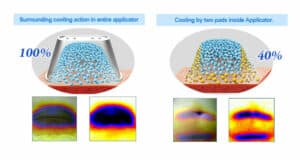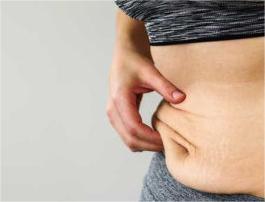
Key Takeaways:
Does cryolipolysis or coolsculpting hurt?
- Most patients report the pain as “slight discomfort” rather than severe pain. It is often described as a cold, stinging, pinching, or aching sensation.
- The pain and discomfort is primarily felt during the first 5-10 minutes of the procedure when the cooling applicator is first applied. After the skin goes numb, patients generally do not feel much or any pain for the remainder of the 60-90 minute treatment.
- Some patients report moderate pain, swelling, numbness, and sensitivity for a few days up to 2 weeks after the treatment. This may come and go but normally does not prevent people from continuing their regular activities.
- A small percentage of patients experience more severe “late onset pain” starting about 4-7 days after treatment, often described as stinging, prickling, or throbbing pain. This can last 1-4 weeks, but there are pain medications that can help manage it.
- To help relieve general discomfort, patients can take over-the-counter pain medications like Tylenol, use ice/heating pads, wear compression garments, and massage the treatment area.
Difference Between Cryolipolysis and Coolsculpting
Coolsculpting and cryolipolysis utilize the same core technology of fat freezing, but Coolsculpting provides the brand name recognition and FDA approval that many patients and providers look for when considering cryolipolysis treatments. The choice comes down to provider, machine, and patient comfort preferences when comparing Coolsculpting vs other cryolipolysis options.
Understanding Cryolipolysis
Cryolipolysis is a safe and effective noninvasive body contouring cosmetic treatment targeting your fat cells. During this process, controlled freezing is applied to your chosen areas, which essentially freezes and destroys adipocytes (fat cells). This method relies on the concept of lipolysis, which is the breakdown of fat.
Here’s how it works:
- Cooling Technology: A device safely cools fat deposits.
- Targeting Fat Cells: Adipocytes are more susceptible to cold than surrounding tissues.
- Natural Elimination: The affected cells undergo apoptosis (cell death).
Post-treatment, your immune system gradually removes the damaged adipocytes. These cells are cleared by macrophages, a type of immune cell, which process the fat and remove it from the body over several months. Since cryolipolysis is noninvasive, it requires no surgical incisions or anesthesia, making it a sought-after option for reducing stubborn fat.
Cryolipolysis Procedure Details
Before delving into the specifics of the procedure, it’s essential to understand that Cryolipolysis, often known to many as CoolSculpting, is a non-invasive method geared towards reducing fat in targeted areas. Your comfort and safety are prioritized throughout the process.
The Role of the Applicator
The applicator is a fundamental component of the Cryolipolysis procedure. During your treatment, the doctor will place this device on the area you’re looking to address. It comes in various shapes and sizes to fit the specific treatment areas of your body effectively. Here’s what happens with the applicator:
- Suction: The applicator uses suction to draw your fatty tissue into the device, maximizing the area’s exposure to cooling technology.
- Cooling: Once the fat is sucked in, the applicator cools the area to a temperature that causes fat cells to crystallize and die without damaging surrounding tissues.
Treatment Session Overview
Your Cryolipolysis session will unfold in the following manner:
- Consultation: Initially, you’ll have a detailed consultation with your doctor to discuss your areas of concern and to outline the treatment plan tailored to your needs.
- Preparation: On the day of the procedure, the treatment area will be prepared with a gel pad to protect your skin.
- Tugging and Intense Cold: As the session begins, you’ll feel a strong tugging sensation and an intense cold. This is normal and subsides as the area becomes numb.
- Duration: Treatment sessions typically last between 35 to 60 minutes per area, depending on the size and number of areas being treated.
- Massage: Once the treatment is done, your doctor will massage the treated area to break down the frozen fat cells, enhancing the procedure’s effectiveness.
Remember, multiple sessions spaced several weeks apart might be necessary to achieve optimal results.
Pain and Sensation During Treatment
When you undergo cryolipolysis, it’s common to experience a range of sensations, from the initial application of the cold to varying degrees of discomfort during the process. Let’s explore what you might feel during the treatment.
Initial Cold and Suction Feelings
As the cryolipolysis device is applied to your skin, you’ll likely feel a distinct cold sensation. This is due to the low temperatures used to target fat cells. Along with the cold, the device uses suction to draw your fatty tissue into the applicator, which might feel like a firm tug on your skin. Usually, this combination of cold and suction leads to an area of your skin becoming numb, which happens quite quickly, minimizing any discomfort as the procedure progresses.
Possible Discomfort and Pain
While the treatment is generally well-tolerated, you might experience some side effects, such as:
- Tingling or stinging: As your skin reacts to the cold, you might feel a tingling sensation.
- Aching: Similar to how your muscles might ache from the cold, your treatment area could feel sore.
- Bruising: The suction effect can sometimes cause bruising on your skin.
- Swelling: It’s a natural response to the treatment and should subside.
- Sensitivity and itchiness: Some people report that their skin feels sensitive or itchy following the procedure.
- Redness: Your skin might look red in the treated areas due to the cold exposure.
Typically, these sensations and side effects are temporary and should resolve on their own within a few days to weeks. If any discomfort persists or is particularly troublesome, reaching out to your provider is recommended to ensure everything is progressing normally.
Benefits vs. Risks of Cryolipolysis

Cryolipolysis offers you a way to reduce fat in targeted areas without surgery, but it’s essential to weigh the benefits against potential risks and side effects.
Compared to Traditional Liposuction
Cryolipolysis and traditional liposuction both aim to reduce fat, but they differ significantly. Cryolipolysis is a noninvasive procedure, meaning no incisions or anesthesia are required. The primary benefit you’ll experience is the reduction of fat in specific areas, which can be achieved without the risks associated with surgical procedures like liposuction. As a noninvasive method, cryolipolysis typically allows for a quicker recovery time, and you can usually resume daily activities immediately.
Potential Side Effects and Complications
While cryolipolysis is generally safe and approved by the FDA, you should be aware of possible side effects and complications:
- Skin sensitivity issues, such as redness, swelling, and bruising, are common but usually temporary.
- More severe side effects, though rare, can include paradoxical adipose hyperplasia (PAH), a condition where the treated area becomes larger rather than smaller.
Potential Complications:
- Pain – Discomfort during and post-procedure can occur.
- Bruising – Common in the treated area due to the suction of the cooling device.
In the case of side effects, they generally resolve within a few weeks. Nonetheless, it’s important for you to consider both the aesthetic benefits and the small risk of complications when deciding on cryolipolysis.
Cryolipolysis Results and Effectiveness
Cryolipolysis, commonly known as fat freezing, is particularly effective for reducing stubborn fat that resists diet and exercise. It’s a non-invasive body contouring method that targets and kills fat cells.
Anticipated Outcome and Timeline
When you undergo cryolipolysis, you can expect a noticeable reduction in fat layers of targeted areas. Full results can take up to 12 weeks to appear as your body naturally processes and eliminates the dead fat cells. The amount of reduction varies, but a 1/2 inch reduction from a treatment area is a typical example based on studies. Remember, this isn’t a weight loss solution but rather a way to smooth out stubborn bulges.
Factors Influencing Effectiveness
- Your physiology: Individual variations in metabolism and fat distribution play a role.
- Treatment area: Certain areas, like the abdomen, back, and flanks, respond well to treatment.
- Protocol adherence: Multiple sessions may be required for optimal results.
- Lifestyle: Maintaining a stable weight through diet and exercise will help preserve the outcome, as remaining fat cells can still expand.
Remember, each body reacts differently, and while you might notice changes comparatively early, it’s important to be patient and wait for the final outcome of the treatment.
Post-Treatment Care and Recovery

After undergoing cryolipolysis, it’s crucial for you to understand what to expect and how to manage the recovery period to ensure your comfort and health.
What to Expect Post-Procedure
In the days following the treatment, you’ll likely observe some changes in the treated area. It’s common to experience redness, swelling, firmness, and tenderness as your skin begins to recover. It’s important to note that recovery time can vary, but typically, these side effects resolve within a few days or weeks. Remember, the skin is resilient and these reactions are a normal response to the cold treatment.
- Redness & Swelling: May last for a few minutes or hours post-treatment.
- Firmness & Tenderness: Can occur due to the treated fat cells crystallizing.
Managing Side Effects at Home
To make sure you’re comfortable during your recovery, a few simple at-home measures can be taken:
- Pain Management: If you experience discomfort, over-the-counter pain relief such as acetaminophen can be helpful. Avoid anti-inflammatories as they may interfere with the inflammatory process that helps remove the treated fat cells.
- Do: Use acetaminophen for pain.
- Don’t: Take anti-inflammatory medication like ibuprofen.
- Skin Care: Gently treat the skin. If blisters or severe redness occur, contact your healthcare provider.
- Do: Apply a cold pack if swelling is uncomfortable.
- Don’t: Expose treated areas to extreme heat or cold outside of treatment parameters.
- Physical Activity: While you can return to daily activities almost immediately, it’s often suggested to wait a few days before engaging in vigorous exercise to prevent further irritation of the treated area.
- Do: Enjoy light activities such as walking.
- Don’t: Rush into high-intensity workouts right after treatment.
- Monitor Your Health: Watch for any signs of unusual side effects. Rarely, more severe issues can occur, and it’s vital to contact your healthcare provider if you have concerns.
- Do: Keep an eye on your body’s reaction post-procedure.
- Don’t: Ignore persistent or worsening symptoms.
By following these guidelines, you’ll be aiding your body’s natural recovery process after cryolipolysis.
Frequently Asked Questions
Is Coolsculpting Painful?
Why might someone experience discomfort following CoolSculpting treatment?
After a CoolSculpting session for fat reduction, it’s not uncommon to feel some discomfort. This happens as your body responds to the controlled cooling, potentially leading to temporary sensations such as pain or aching at the treatment site.
What can be done to alleviate discomfort after undergoing a CoolSculpting procedure?
To alleviate discomfort following CoolSculpting, you can apply gentle compression and use over-the-counter pain relief if necessary. Ensuring to rest and applying cold compresses can also help mitigate any pain.
How long do CoolSculpting-related sensations typically persist post-treatment?
Typically, any numbness or discomfort experienced after CoolSculpting resolves within a few weeks. Sensations like tingling or stinging should diminish as the treated area recovers.
What are some common side effects associated with CoolSculpting?
Common side effects of CoolSculpting include temporary redness, swelling, bruising, and skin sensitivity in the treated areas. These are typically mild and resolve on their own.
Which areas of the body may feel more sensitive after CoolSculpting?
Areas with more nerve endings, such as the abdomen and flanks, may feel more sensitive post-CoolSculpting. Different individuals might experience varying sensitivity levels based on their unique bodily responses.
Are there any recommended activities or restrictions following a CoolSculpting session?
Although CoolSculpting is nonsurgical, after that, it’s usually recommended to avoid strenuous activities for a short period to allow your body to heal. You should also stay hydrated and follow any specific care instructions provided by your clinician.






